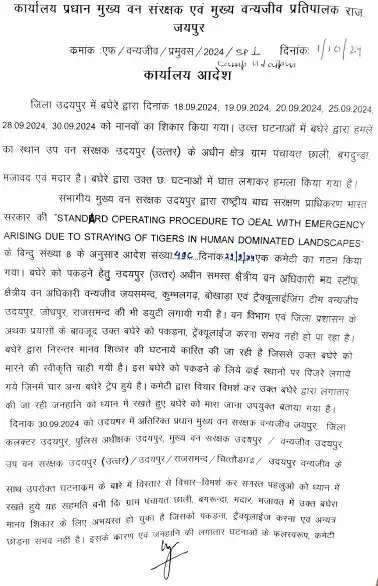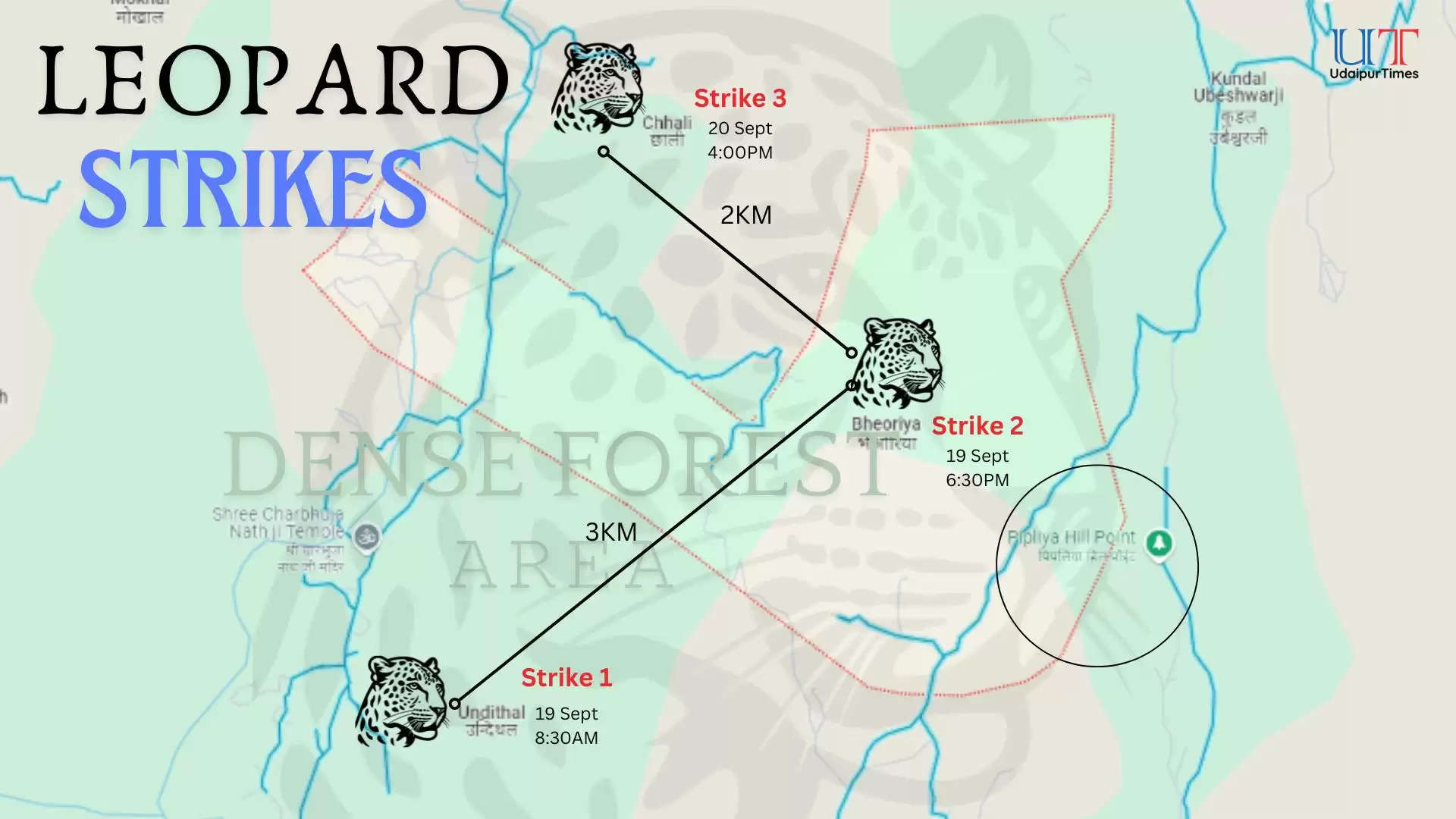Forest Department Panel Orders Killing of Man-Eater Leopard Once Captured
Department officials confirm man-eater still at large; captured leopards not the ones behind attacks on humans
Udaipur, October 1, 2024 – Pavan Kumar Upadhyay, the Principal Chief Conservator of Forests and Chief Wildlife Warden, Rajasthan, Jaipur, has issued an order with regard to the man-eater leopard on the prowl in Udaipur forests deeming it appropriate to kill the leopard considering the circumstances. This decision was taken by a panel formed to assess the current situation in which a leopard has killed humans in separate attacks in the region recently.
The Chief Conservator of Forests, Udaipur, had formed a committee based on Point 8 of the Government of India’s National Tiger Conservation Authority’s ‘Standard Operating Procedure to Deal with Emergency Arising Due to Straying of Tigers in Human Dominated Landscapes’ (Order No. 118, dated 21.09.24). Duties were assigned to all regional forest officers under Udaipur (North), along with staff, and the regional wildlife officers of Jaisamand, Kumbhalgarh, Bokhada and tranquilizing teams from Udaipur, Jodhpur and Rajsamand.
Despite efforts by the authorities, the leopard remains at large and continues to attack humans. Several cages have been set up in various locations, leading to the capture of four other leopards. Therefore, the panel sought an approval to kill it once it is found.


On September 30, 2024, a detailed discussion was held in Udaipur among the Additional Principal Chief Conservator of Forests (Wildlife) Jaipur, the District Collector Udaipur, the Superintendent of Police Udaipur, the Chief Conservator of Forests Udaipur/Wildlife Udaipur, the Deputy Forest Conservator Udaipur (North) and other forest officials from Udaipur, Rajsamand and Chittorgarh.
After reviewing all aspects, it was agreed that the leopard, which has been preying on humans in the villages of Chhali, Bagrunanda, Madar and Majawad, has become habituated to hunting humans and it was neither possible to capture nor tranquilise and relocate it. Therefore, considering the circumstances the committee has issued a recommendation that the leopard be killed for the safety of the people.
Accordingly, under the powers granted by Section 11, Sub-section 1(A) of the Wildlife Protection Act 1972, permission has been granted to the Deputy Forest Conservator Udaipur (North), with the cooperation of district administration and district police, to kill the man-eater leopard, subject to the following conditions:
- Every possible effort must be made to first tranquilise or trap the leopard.
- The leopard’s correct identification must be ensured before killing it.
- A daily report must be submitted to the committee and the Chief Wildlife Warden of Rajasthan regarding this matter.
What is Point No. 8 of the Wildlife Protection Act 1972
The Standard Operating Procedure (SOP) provides the basic, minimum steps which need to be taken at the field level (whether it is the tiger reserve or elsewhere) for dealing with incidents of tigers straying in human dominated landscapes. Point no. 8 requires that at the outset, a committee should be set up immediately to provide technical guidance and monitoring on day-to-day basis. Identity of the animal needs to be established and if successive trapping efforts fail, chemical immobilisation of the wild carnivore should be carried out by an expert team comprising a veterinarian.
Under no circumstances, a tiger should be eliminated by invoking the Wildlife (Protection) Act, 1972, if it is not habituated for causing human death.
What is Section 11 of the Wildlife Protection Act 1972
Section 11 (annexure ii) provides the guidelines for declaration of big cats as ‘dangerous to human life’. Under Section 11 (1) (A)), it is stated that both tigers as well as leopards are known to cause habituated loss of human life. Such confirmed animals which have come to be known as having become ‘dangerous to human life’ should be eliminated as per the statutory provisions provided in Section 11 of the Wildlife (Protection) Act, 1972.
Leopards, as also tigers, are categorised under Schedule 1 of the Wildlife (Protection) Act, 1972, with highest statutory protection against hunting under Section 9 (1) of the said Act. Therefore, such species can be killed if they become dangerous to human life or are so disabled/diseased beyond recovery.
Under Section 11 (1) (a) of the Wildlife (Protection) Act, 1972, the Chief Wildlife Warden of a State alone has the authority to permit hunting of such animals becoming dangerous to human life or disabled or diseased beyond recovery. However, he/she has to state in writing the reasons for permitting elimination before hunting.
7 Killed in 13 Days within 40km of Udaipur
The man-eater Leopard began its attacks on human targets on September 19 and till October 1, at the time of publishing this post, has killed 7 people in the northern upcountry areas of Udaipur.
- Sept 19: a 16 yr old boy and a 65 yr old man killed at Undithal and the other at Bheoriya village in the Chhali Panchayat under Gogunda Tehsil, Udaipur,
- Sept 20: 50 yr old lady killed at Umariya, again in Chhali Panchayat of Gogunda Tehsil,
- Sept 25: 5 yr old girl killed at Kundad village in Majawad Panchayat of Gogunda Tehsil,
- Sept 28: 65 yr old woman killed at Gurjaron ka Guda, in Majawad Panchayat,
- Sept 30: a temple priest (Pujari) killed in the temple premises in Madar Panchayat, Badgaon Tehsil adjacent to Udaipur city,
- Oct 1: woman killed at Kelvo ka Kheda, Madarda Panchayat, Gogunda Tehsil.
The animals captured on September 24 from Chhali Panchayat after the first three kills, was initially said to be a the man-eater, but with growing attacks, the department has concluded that the man-eater is still at large. However, the probability of there being more than one man-eater, cannot be ignored. Whether it is the same animal doing the rounds or another, remains to be seen.
To join us on Facebook Click Here and Subscribe to UdaipurTimes Broadcast channels on GoogleNews | Telegram | Signal



